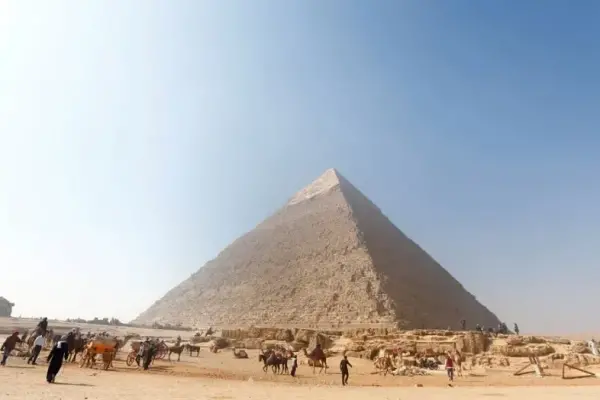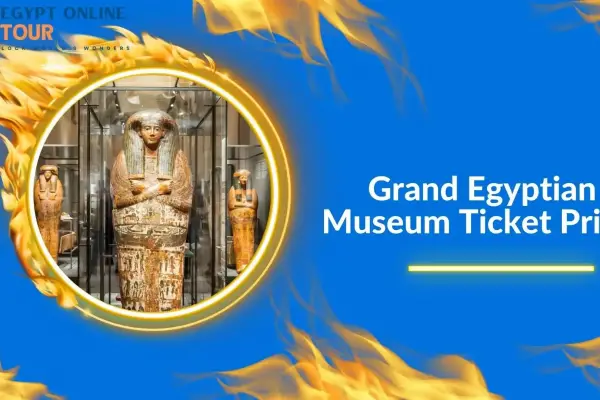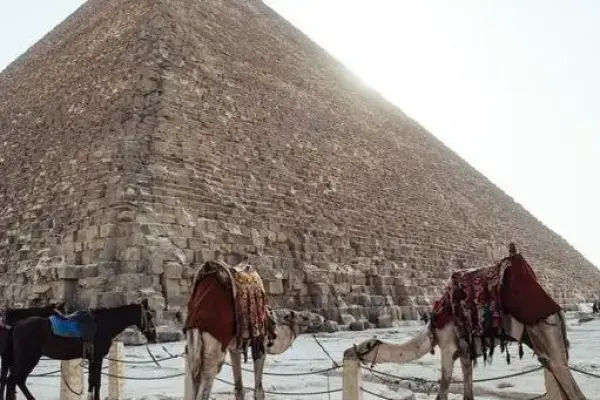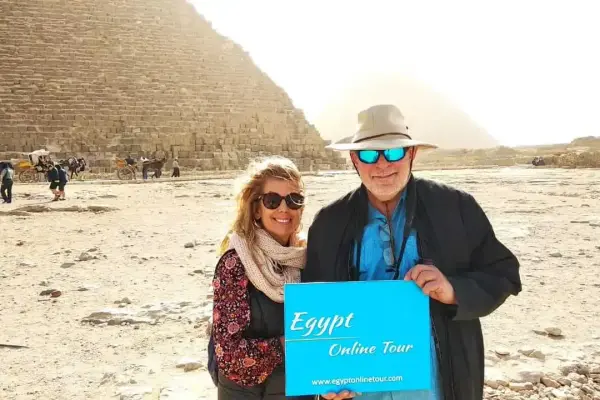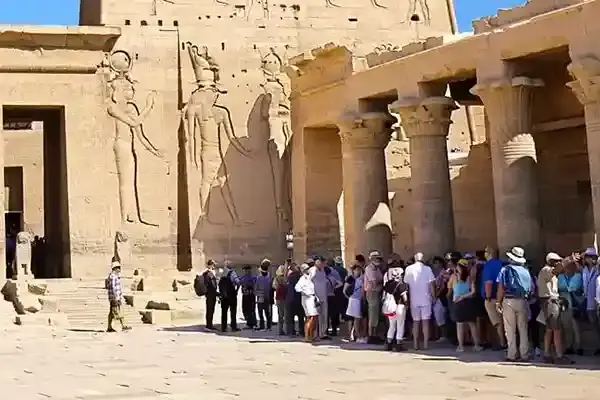Queen Nefertari – The Timeless Beauty of Ancient Egypt
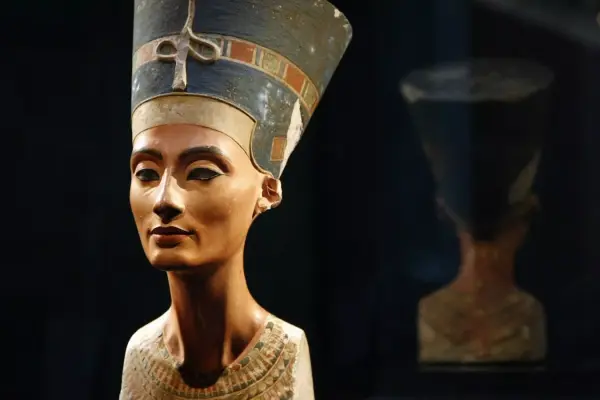
- Sep 24, 2024
- Ancient Egyptian Pharaohs & Rulers
- 8,395
The first documented love poem spoken in history was spoken by King Ramses II to his wife, Queen Nefertari, in which he said, "She is the one for whom the sun rises." The phrase is still engraved on the walls of the Abu Simbel Temple to this day. In this article, we'll explore all the queen's secrets, her love story, and everything about her temple. Follow along.
Table of contents [Show]
- Queen Nefertari History
- Queen Nefertari
- Titles of the Queen Nefertari
- Queen Nefertari's real face
- Marriage to Ramesses II
- Ramses and Nefertari Love Story
- The extent of her power and influence
- The Family
- Queen Nefertari's children
- Queen Nefertari's cause of death
- Queen Nefertari Facts
- Abu Simble Temple of Nefertari
- The discovery of her lavish tomb
- Queen Nefertari Tomb QV66
- Planning Your Visit
Queen Nefertari History
Queen Nefertari's history is replete with examples of her kind, and she is also one of the most distinguished and powerful women of ancient Egypt. Not only was she the wife of Ramesses II (the greatest pharaoh of the 19th Dynasty), but she also played a significant religious role. She built numerous temples and shrines for the gods, such as the Temple of Hathor in Abu Simbel, which you'll see on your Aswan tour. Bonus information: She corresponded with the Hittite kings in Anatolia to settle political disputes!
As the historian Manetho said, "The women of the royal palace in Egypt were pillars of the kingdom, building peace with wisdom."
She was born in the late 18th or early 19th Dynasty (c. 1300 BC), and there is no precise information about her lineage, which makes her a fascinating mystery in Egyptology. Ancient sources state that Nefertari was born around 1370 BC in Thebes, but the truth is that this date is incorrect and has been confused with Nefertiti.
So, the most accurate information is that Queen Nefertari was most likely born around 1300 BC. Her exact lineage is unknown, meaning it's not certain whether she was from the royal family or a priestly family, but it's most likely she was from a prominent family in Thebes.
Researchers believe her origins may be Nubian, as inscriptions in Nubian temples strongly depict her, but there is no definitive proof.
Aidan Dodson's book - Royal Families states, "The lack of a clear genealogy for Queen Nefertari makes her one of Egypt's most mysterious queens."
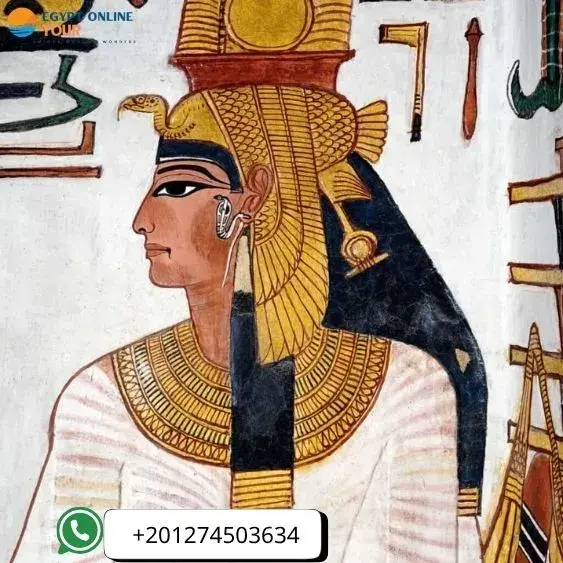
Queen Nefertari
Nefertari Merit-en-Mut, whose full name means "Beautiful Companion, Beloved of the Goddess Mut."
Queen Nefertari was one of the greatest and most famous women in ancient Egyptian history. Not only because she was the wife of Pharaoh Ramesses II, one of the most powerful kings of Egypt, but also because she was a cultured, religious woman with significant influence in government and politics.
She loved building temples and shrines, not only for herself, but also for the gods she believed in.
A relief in the Abu Simbel Temple depicts Nefertari making offerings to the goddess Hathor, clearly demonstrating her religious role—not just as a king's wife!
In his book "Nefertari: For Whom the Sun Shines," researcher Christian Leblanc says:
"Nefertari not only embodied the image of a queen, but also combined the image of a wife, a priestess, and a cultured woman."
Titles of the Queen Nefertari
Queen Nefertari Merenmut (1303–1255 BC) was not just the wife of Ramesses II; she was a co-ruler, possessing unprecedented religious and political authority among women in the royal court of ancient Egypt. This role is evident in a series of official and religious titles she held, which served as sacred royal documents, confirming her greatness and eternal status.
Watch the greatness by yourself with the best Egypt Classic Tours .
Official Titles – Co-ruler
Nefertari held traditional titles given to the wives of pharaohs, but their meaning carried exceptional political weight:
Hieroglyphic Title | Translation Meaning
|
𓈖𓃀𓏏 𓏏𓅱𓇋 (nbt tȝwy) | Lady of the Two Lands, indicating her authority over Upper and Lower Egypt—a title granted only to kings or those of pharaonic rank.
|
𓇋𓏏𓏠𓈖𓏏𓇳 (ḥmt nswt wrt) | The Great Royal Wife confirms her position as the principal wife, making her first in the royal line.
|
𓏏𓏏𓄟𓂝𓏤 (sȝt nswt) | The King's Daughter hints at her possible royal origin, perhaps referring to her lineage from Seti I |
At Abu Simbel, Nefertari appears as an equal to Ramesses in the wall statues—a very rare representation of any queen.
Joyce Tyldesley's book, Nefertari: Queen of Egypt, says, "Nefertari's titles were not an embellishment of the position, but a public acknowledgment that she was a co-ruler."
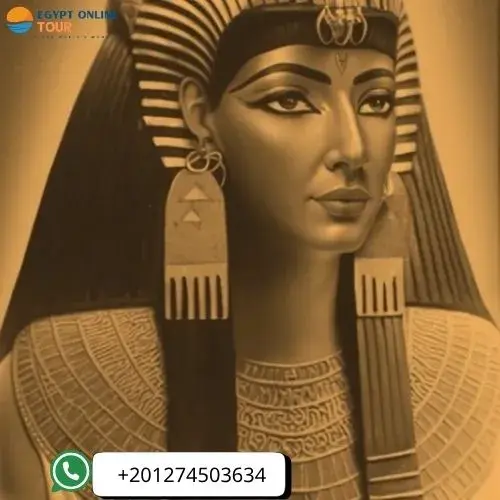
Religious Titles – Sacred Status
Nefertari was not only the mistress of the palace, but she also had an active religious role, perhaps a quasi-priestess, as evidenced by the following titles:
Hieroglyphic Title | Translation Evidence
|
𓂦𓇯𓂋 (dwȝt nṯr) | Worshipper of the God. Found inscribed on the walls of the small temple of Abu Simbel, where she is depicted offering sacrifices.
|
𓇋𓏏𓈖𓏏𓂋 (ḥmt nṯr) | Wife of the God. This is considered one of the highest religious titles, and is documented in her tomb in QV66.
|
𓇓𓂋𓇋𓇋 (tȝ wrt n ḫt.f) | The Great Beloved of Him. This inscription was found on one of the obelisks at Abu Simbel.
|
The title "God's Wife" was not common among queens; rather, it was given to priestesses in Thebes, making Nefertari a rare exception.
The study The Titulary of Nefertari – Journal of Egyptian History states, "The use of the title 'God's Wife' in Nefertari's case is not merely religious... but rather an assertion of dual religious-political authority."
The Mythical Title – "For Whom the Sun Rises"
One of Nefertari's most famous titles is a stunning inscription in tomb QV66, which reads in hieroglyphs:
𓂋𓈖 𓂋𓁹 𓈖 𓄤 (rn n rˁ n nfr.t ỉrỉ)
| Meaning: "The name of Ra creates beauty."
| Symbolic Meaning: Nefertari's beauty is sacred, as if the god Ra himself created her features. This places her in a position resembling the sun, the supreme symbol of the god Ra in Egyptian belief.
|
Archaeological Evidence:
- A famous scene inside the tomb shows Nefertari surrounded by light, wearing a golden crown and calm features illuminated by colors.
As stated in the History Channel documentary Nefertari: The Sun Queen, "Her title was not a poetic metaphor... but a divine declaration that this woman was unlike any other."
Political Titles - Establishing Legitimacy
Hieroglyphic Title | Translation Meaning |
𓇋𓂋𓏏 𓊪𓏏 (ỉrỉt-pˁt) | Hereditary Nobleman indicates that she was of noble lineage, granting her sons, such as Prince Merneptah, the legitimacy to rule.
|
𓐍𓈖𓄿𓏏 𓋹𓈖𓏏 (ẖnmt ˁnḫ n ỉmn) | Life Companion of Amun, linking her directly to the god Amun, thus religiously strengthening Ramesses' rule.
|
The Hittite king's letter to Ramesses II (Royal Marriage Papyrus): "Why do you treat your wife as if she were a ruler?!"
This is evidence that her power extended beyond Egypt's borders, reaching the eyes of foreign kings.
Watch this power in reality via best Egypt tour packages with Egypt online tour
Why were Nefertari's titles exceptional?
Nefertiti held titles such as "Mistress of All Women," but she was not granted the same religious status as Nefertari.
Queen Hatshepsut proclaimed herself pharaoh, but she was not titled "God's Wife," choosing a completely separate path.
The message was clear: Nefertari was not behind the throne... but right beside it.
As Zahi Hawass also said: "Nefertari's titles are her passport to immortality. She is the queen who compelled history to remember her on a par with the greatest kings on earth."
Supporting archaeological evidence:
- The Little Temple of Abu Simbel: Statues of Nefertari stand next to statues of Ramesses of almost the same size—a unique precedent in royal art.
- Hathor offering inscriptions: They show her performing priestly rites herself, confirming her title as "Priestess of Hathor."
- The "Love of Nefertari" papyrus: A rare literary text depicting her as a symbol of beauty and wisdom, and a source of poetic inspiration
Let our local travel experts help you design the perfect itinerary. Whether you're seeking adventure, culture, or relaxation, we've got you covered!
Queen Nefertari's real face
Queen Nefertari Merenmut (c. 1290–1255 BC), wife of King Ramesses II and "the Lady of Love and Eternal Beauty," is famous in inscriptions for her breathtaking beauty, but her true features remain a scientific mystery, the subject of much research and discovery. To understand her true face, researchers have relied on three main axes: ancient Egyptian art, archaeological and biological evidence, and digital reconstruction attempts.
Artistic artifacts – the clearest depiction of her features
The clearest sources of Nefertari's face are ancient Egyptian art, particularly the murals of her tomb QV66 in the Valley of the Queens in Luxor, which are considered among the most beautiful tombs ever discovered. The drawings depict her with delicate features:
- Large almond-shaped eyes covered in black kohl.
- A straight, thin nose, and a small mouth with a serene smile.
- Relatively light skin, especially compared to statues of Ramesses II.
The colors of the inscriptions remain vivid to this day, such as royal blue and gold, giving her features exceptional clarity.
Archaeological Evidence: A famous mural inside tomb QV66 depicts Nefertari making offerings to the goddess Maat, depicting her facial features with astonishing precision, almost on par with modern art.
From the book "Nefertari: For Whom the Sun Shines" (Erico De Luca): "The art in Nefertari's tomb was not merely symbolic; it was a true reflection of her personal status, and even her features."
Enjoy seeing the real beauty within Luxury Egypt Tours .
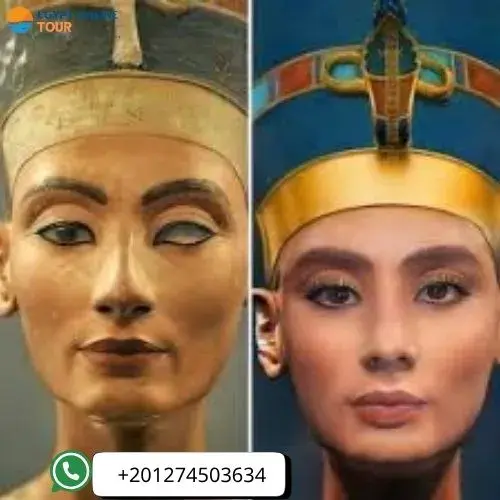
The Scientific Controversy Over Her Mummy
In 1904, researcher Ernesto Schiaparelli discovered tomb QV66, but it was empty except for the remains of two knees wrapped in linen. In 2017, Dr. Zahi Hawass announced that these remains were likely Nefertari's, based on:
- The discovery of linen inscribed with Nefertari's name.
- Biological analysis showed that the mummy was approximately 40 to 50 years old, an age consistent with estimates of her death.
However, in 2020, researcher Susannah Eagle published a counter-study in the Journal of Archaeological Science, questioning this:
- DNA results did not show a match with the 19th Dynasty.
There is a possibility that the linen was reused at a later period.
Quote from the study: "So far, it is not possible to definitively identify the mummy found as Queen Nefertari... The absence of a skull renders any facial reconstruction inaccurate."
Attempts to Reconstruct Her Face
Despite the absence of her skull, researchers at the University of Bristol attempted in 2018 to reconstruct a virtual face of Queen Nefertari, based on:
- Skull measurements from the same period (to represent shared genetics).
- Her statues at the Abu Simbel Temple and the Egyptian Museum.
The result was an oval-shaped face, prominent cheekbones, wide eyes, and well-proportioned features, very similar to the mural carvings. It was interesting to note that ancient Egyptian art often embellished the features of queens, but in the case of Nefertari, scholars believe the drawings were close to reality, not exaggerated.
Why did scholars disagree about her features?
The reason | The scientific explanation |
The mummy was damaged | The skull is missing, so the facial shape cannot be accurately analyzed |
The artistic style | Some murals are idealized, especially in religious roles. |
The lack of DNA and the deterioration of the samples prevented conclusive results.
We have a general idea of her features from the carvings: almond-shaped eyes, a thin nose, fair skin, and an oval face. However, there is no conclusive evidence from the mummy due to the loss of the skull and the controversy surrounding her identity. The digital reconstruction provided a close approximation, but it does not replace direct archaeological evidence.
As Dr. Joan Fletcher (British Egyptologist):
"Nefertari's beauty was not a myth... but a woman who left her face indelibly etched on the walls of eternity."
Marriage to Ramesses II
Ancient Egyptian history may be rich with kings and queens, but rarely has there been a relationship as passionately entwined as that of Ramesses II and Nefertari Merenmut. Their marriage, which took place early in Ramesses' reign around 1279 BC, was not just a royal alliance, but an extraordinary love story documented by archaeological evidence and passionate texts—so much so that the sun itself, it was said, "rises for her."
She married Ramesses II before he became king, when he was still the crown prince and the son of Pharaoh Seti I. This suggests that their relationship was not a political marriage of convenience after his accession to the throne, but rather one built on a preexisting relationship and mutual trust.
In the first year of Ramesses's reign, the royal wedding was held in Memphis. The Harris Papyrus refers to a mythical scene: "He brought her into the palace amidst the cheers of the people... as if she were Isis being wed to Osiris."
Research indicates that Nefertari was descended from a noble lineage and may have been the granddaughter of King Ay, which strengthened Ramses' political legitimacy.
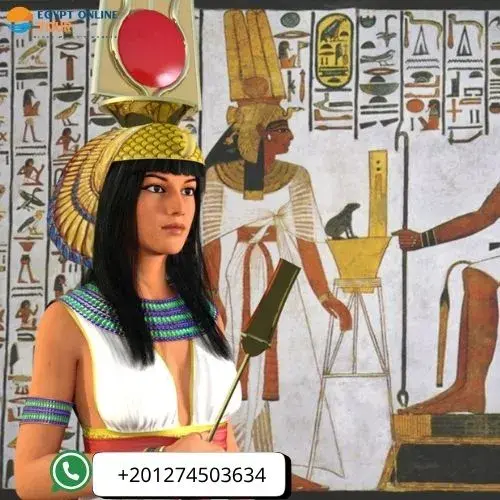
Ramses and Nefertari Love Story
In 1255 BC, Ramses II carved an entire temple into the rocks south of Aswan and dedicated it to Nefertari and the goddess Hathor, the symbol of love and music.
It contains six colossal statues: four of Ramses and two of Nefertari of equal size—a rarity in Egyptian art, as queens were usually depicted at much smaller sizes.
On its facade, the mythological inscription reads: "Originated for his beloved wife Nefertari... for whom the sun rises."
(Inscription engraved above the temple gateway, photo from the Little Temple of Abu Simbel)
As Weeks puts it in "Ramesses the Great": "This was not just a religious temple... but a declaration of eternal love carved into the rock."
Love Letters in the Pharaonic Papyri
The Chester Beatty Papyrus, preserved in the British Museum (EA 10684), contains one of the earliest romantic poems written in the name of a pharaoh:
- "O fair-faced one... my happiness is to see you, my heart flutters like a fish in your hand."
- It is also said that Ramesses wrote to the Hittite queen after the death of Nefertari: "I have lost my irreplaceable wife... no joy in Egypt after her."
- From the study "Love Songs in the New Kingdom" by Dr. Amy Callender: "Ramesses did not write love lyrics... but rather carved his feelings into the heart of civilization."
- The queen was also treated exceptionally, as evidenced by:
- Co-rule, appearing alongside him in reliefs of the Battle of Kadesh (Karnak Temple).
- Royal titles, bearing the title "Lady of the Two Lands"—a title only given to the pharaoh or his co-ruler.
- He built a special funerary temple for her in Thebes (now extinct).
- No wife was given the title "For Whom the Sun Rises" after her.
- In the Luxor Temple, reliefs of Ramesses appearing with her on early occasions before his accession to the throne indicate her special status from the beginning.
- Ramses II's choice of Nefertari as his Great Royal Wife early in his reign demonstrates his admiration for her intellectual and religious status, not just for her beauty or her ability to bear children.
- The royal tomb, QV66, is the largest and most lavish among the women of ancient Egypt.
The extent of her power and influence
Inside her tomb, inscriptions were inscribed similar to those given to kings, and she was buried with golden amulets in the form of the goddess Isis and linen inscribed with the words: "God's Wife, Beloved of Ra."
From historian Joyce Tyldesley: "Nefertari was the great love of Ramesses's life... and he mourned her until his death 48 years later."
"When Nefertari's image was carved beside Ramesses's statue, she was not just his wife... but his other soul." – History Channel, from the documentary "Nefertari: The Sun Queen".
Queen Nefertari-Mernmut was not just a wife under Ramesses II; she was a woman who held the reins of religious and political influence during the most dangerous periods in Egypt's history. Her power extended beyond ceremonies and statues, reaching into the temples of Amun and the corridors of international diplomacy.
1. Religious Influence:
The title "God's Wife" (ḥmt nṯr) was not merely a symbolic honor. An inscription at Lisht indicates her oversight of the Karnak rituals and the kingdom of Amun. At the Abu Simbel temple, she is depicted offering sacrifices to the goddess Hathor, a role usually reserved for the pharaohs themselves—a sign of the sanctity of her presence.
2. Political Influence:
Nefertari played a mediating role in one of the oldest peace treaties in history: the Treaty of Kadesh with the Hittites (1258 BC). Her name was even mentioned in a letter sent by the Hittite Queen Pu-dubi, preserved in the Hattusa Archives, as part of a unique female diplomatic exchange.
3. Financial Power:
A stela in Luxor depicts her receiving tribute from the Nubians alongside Ramesses—a rare sight of a woman exercising symbolic financial power in the royal court.
The documentary "Nefertari's Lost Dynasty" states that Nefertari was a rare embodiment of soft power, redefining the status of women in ancient Egypt.
Let our local travel experts help you design the perfect itinerary. Whether you're seeking adventure, culture, or relaxation, we've got you covered!
The Family
Although she bore six sons and two daughters, none of them inherited the throne. They all died during their father's lifetime, prompting Ramesses to later grant rule to his son by another wife (Merneptah).
Her relationships with the other women in the family were unrecorded, and little is known about them. For example:
Relationships within the Palace
- Tuya (her mother-in-law): Nefertari was placed above her in ritual inscriptions, reflecting her dominance within the court.
- Isis Nofret (secondary wife): She is never mentioned alongside Nefertari, which suggests a tense relationship, perhaps as a result of competition over the succession of the sons.
Queen Nefertari's children
Here is a table showing the Queen nefertari children, their roles, and their fates:
Name | Role | Fate |
Amun-her-khepeshef | commander of the army | died young. His statue is in the Turin Museum |
Pareh-her-wenmef | priest of Amun | inscription at Abydos |
Merriamun | ruler of Memphis | stela at Karnak |
Merriatum | priest of Ra | mentioned in the Harris Papyrus |
Nepettawy | princess who married a priest | Her statue is in the Egyptian Museum |
Merit-amun | priestess of Hathor | inscription at tomb QV68 |
It is mentioned in the book "The Children of Ramesses II" by Dr. Faiza Heikal that Nefertari's children were a symbol of a golden age that began quickly and died silently. Tomb QV55 (her son):
Rare murals depict mother and son together, and a poignant inscription reads: "The king's son... from the body of the beloved Nefertari."
Despite the demise of her immediate descendants, Nefertari's legacy endures:
- Her tomb QV66 is the most beautiful in the Valley of the Queens.
- Statues of her and her sons are displayed in the world's greatest museums.
- Her story with Ramesses has inspired novels and legends.
Dr. Zahi Hawass has expressed this sentiment by saying, "Nefertari was not just a wife... but a costly failed dynastic project."
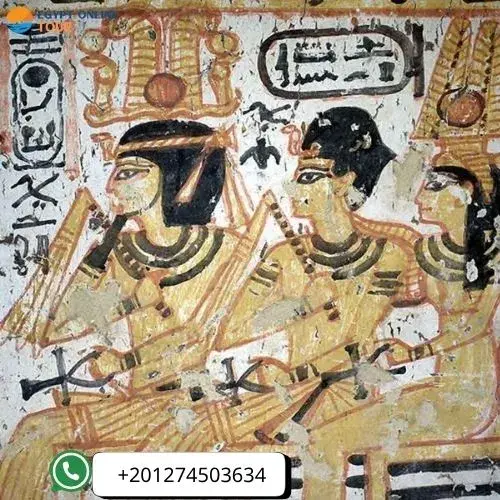
Queen Nefertari's cause of death
The death of Queen Nefertari remains a perplexing mystery in Egyptology. Despite much written about her romantic and political life, her death raises many scientific questions to this day.
In 2017, a team led by Dr. Francesco Galassi at the University of York published an analysis of the remains of two kneecaps believed to belong to Nefertari, discovered in her tomb QV66. The analysis revealed severe wear and tear on the knee joints, suggesting osteoarthritis or degenerative arthritis, diseases that cause chronic pain and persistent lameness.
The bones were between 40 and 50 years old at the time of her death—roughly matching historical estimates of her death around 1255 BC.
Did she suffer from an infectious disease?
In 2020, another study indicated the presence of parasitic DNA residues in her soft tissue, possibly indicating malaria or cutaneous leishmaniasis. However, given the absence of a complete mummy and the reliance on fragmented remains, the evidence remains inconclusive.
Some of her tomb murals show her leaning on a cane, a rare depiction of a queen in her full elegance but with a frail physique. In the "Crossing the Underworld" scene, she is depicted as young, despite her middle-aged death, which may indicate a long struggle with illness.
One of the most eloquent quotes after her death was Ramses's message to the Hittite king: "There is no place for joy in Egypt after her departure..."
Scientifically, the possibility of an assassination has been denied, as there were no wounds or poisons. The possibility of a childbirth death has also been denied, as her last child was born more than 10 years before her death.
Queen Nefertari Facts
In a world dominated by the pharaohs, Nefertari Merenmut emerged as a unique female icon—not only in beauty, but also in influence and immortality.
- Full name: Nefertari Merenmut = "The Beautiful and Beloved, Beloved of the Goddess Mut" Inscribed in tomb QV66
- Date of birth: c. 1290 BC, inferred from marriage and era
- Duration of influence: approximately 25 years as Great Royal Wife (1279–1255 BC) Luxor Temple records
- The first queen to have a statue the size of the pharaoh in the Little Temple of Abu Simbel.
- The only one to hold the title of "God's Wife" without being a priestess—an exception in the traditions of Amun.
- Her tomb (QV66) is the largest and richest royal tomb in the Valley of the Queens:
Area: 520 square meters
Gold layers in the painting
Estimates by the Italian expedition (1992): The equivalent of 100 kg of gold was used!
- An ambassador of peace, as a document preserved in the Istanbul Museum refers to secret letters she sent to the Hittite queen to resolve the post-Kadesh crisis.
- A palace tutor, as the Anastasi Papyrus indicates that she oversaw the education of the children of diplomats and foreign princes in the royal palace.
- A popular saint, as small statues of her were found in Egyptian homes 200 years after her death – placed there for protection and blessing.

Abu Simble Temple of Nefertari
Deep in southern Egypt, next to the Great Temple of Ramses II, stands the Little Temple of Nefertari as an unparalleled architectural masterpiece, not only because it was carved into the rock but also because it is the first and rarest temple built for an Egyptian queen with statues the size of the pharaoh himself.
Her remarkable temple at Abu Simbel
The temple's facade features six colossal statues (each about 10 meters tall):
- Four of them depict Ramses II, wearing the war crown and the double crown.
- Two of them depict his beloved wife, Nefertari, wearing the crown of Hathor (the solar disk between two horns), a rare precedent in Egyptian art.
The foundation inscription above the entrance clearly expresses her status:
- "This divine house was erected for the great queen Nefertari... for whom the sun rises."
Common Sanctity and the Solar Phenomenon
The inner sanctuary is dedicated to the goddess Hathor, goddess of love and music. But most importantly, the drawings depict Nefertari herself making offerings and witnessing Ramesses' coronation by the goddess—as if she were his partner in holiness, not just a courtier.
The most remarkable event, however, occurs twice a year (February 22 and October 22), when the sun's rays penetrate the Holy of Holies to illuminate the statues of Ramesses and Ra-Horakhty, leaving the statues of Amun and Ptah in shadow—a cryptic message: "Ramesses and Nefertari... sons of the sun."
A Cairo University study (2009) meticulously documented this phenomenon as a rare combination of architecture, astronomy, and religion.
Try to see the temple from the river via Dahabiya Nile Cruises to taste the real magic.
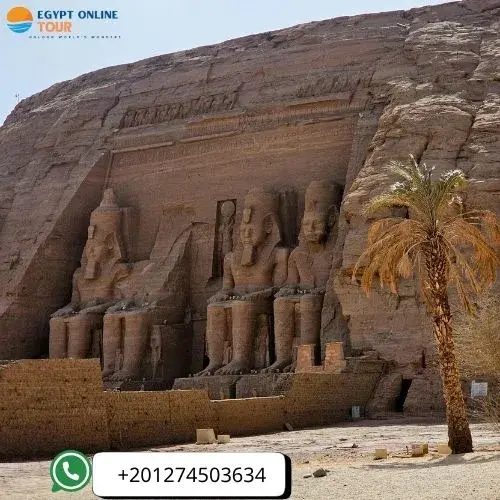
The discovery of her lavish tomb
In 1904, Italian Egyptologist Ernesto Schiaparelli astonished the world when he discovered one of ancient Egypt's greatest tombs in the Valley of the Queens: the tomb of Nefertari Merenmut, a symbol of beauty and wisdom. Mythical Design and Spiritual Messages
Queen Nefertari Tomb QV66
Although the tomb was covered in a black layer of fungus, its original colors remained as vivid as if they had been painted yesterday.
- The Descending Corridor: Nefertari Playing "Senet" with the Goddess → Spiritual Intelligence. The Challenge in the Afterlife
- The Burial Chamber: Blue Ceiling with a Starry Sky, Walls Decorated with the Book of the Dead. Immortality and Protection of the Soul
- The (Stolen) Coffin: Pink Granite, Buried Empty, Believed to Be the Effect of Looting
- The blue colors were made from Afghan lapis lazuli, and the red from Spanish sapphire—evidence of a widespread pharaonic trade network.
- The Most Expensive Architectural Restoration in the History of Tombs
Between 1986 and 1992, the Getty Institute, in partnership with the Supreme Council of Antiquities, led a massive restoration project of the tomb:
- The fungus and salts were meticulously removed.
- The paintings were re-established with resin injections.
- The project cost $6.5 million—the most expensive tomb restoration to date.
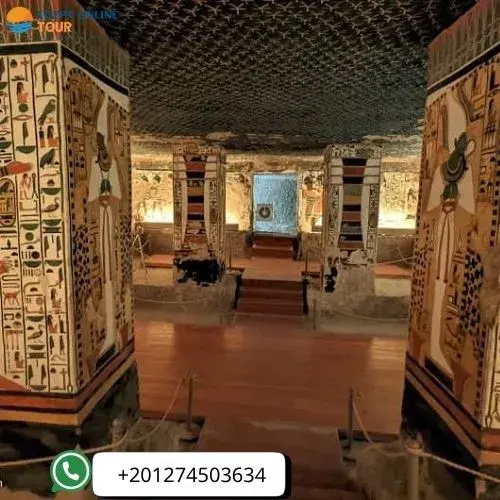
Tomb of Queen Nefertari in Photos
The most notable visual scenes were:
- Isis holding Nefertari's hand: ensuring resurrection and immortality.
- The crossing of the underworld: the soul's survival through the sea of fire with the help of the gods.
- The offering of the lotus flower to Amun: a symbol of creation and renewal.
Nefertari's tomb is the Mona Lisa of ancient Egypt, with every line telling us of love, power, and immortality.
Planning Your Visit
If you're planning to visit the Temple of Nefertari or her tomb in the Valley of the Queens, then the trip must be authentic.
Visiting a place like the Little Temple of Abu Simbel, which combines love, power, and beauty, or the tomb of Queen Nefertari QV66, described as "the most beautiful tomb in ancient Egypt," requires organization befitting its grandeur.
And only Egypt Online Tour with best Egypt Budget Tours can provide you with this experience with all the thoughtful details. From the moment you arrive in Aswan, you'll find everything ready:
- Comfortable transportation.
- Guides who are experts in history and mythology.
- Organized entry to Abu Simbel and precise times to witness the sun's alignment (if you book in time!).
Let our local travel experts help you design the perfect itinerary. Whether you're seeking adventure, culture, or relaxation, we've got you covered!
Amazing visit with Egypt Online Tour
And we won't leave you without photos to document the moment!
And the tomb of Nefertari, whose entrance is very limited (150 people per day for only 10 minutes!), can be guaranteed with Egypt Online Tour, and you can experience one of the rarest spiritual and artistic moments of your life.
Whether you're looking for a romantic getaway, an archaeological adventure, Egypt Vacation Packages , or even a meditation session and Egypt Adventure Tours in front of the world's greatest mural art, experience Egypt as it truly is: a true legend, replete with colors and history. Book your trip now with Egypt Online Tour and let Nefertari tell you her story herself.
Popular Categories
Popular Posts

Top Alexandria Beaches You Must Visit 2026

What are the important holidays in Egypt?
